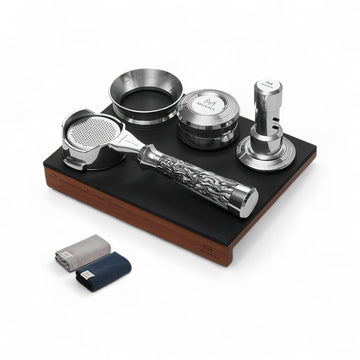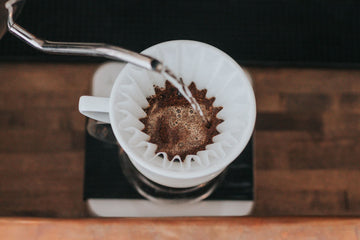If you are trying different coffee brewing, you could be feeling upset because of the grind size. What types of grind are best for Espresso, French Press, and a lot of coffee shots? You tend to buy pre-ground beans as you do not want to waste the time to grind coffee beans. However, you should not pick pre-ground coffee beans anymore if you want to be a true coffee connoisseur. Let’s read the article first to explore the filter coffee grind size.
Filter coffee grind size and brewing method
Coffee grinders could be divided into 2 core camps – blade grinders and burr ones. Blade grinders function as a food processor or a blender, applying spinning blades to cut coffee beans into smaller particles. The longer the grinder acts, the more coffee elements can contact the blades as well as the smaller ones they get.
Burr graders are essentially 2 interlocking discs (they could be flat or conical). However, they can work similarly in some cases with sharp teeth. The materials are ceramic or stainless steel. The grind size on a blade grinder is decided by time, but the distance between the burrs might impact how large coffee grounds end up.
Well, coffee is amorphous as it does not physically break into small particles. Even in a burr grinder (with unusual shapes), larger particles will go through the burrs. Some small dust-like particles will be made at the same time. Most of the coffee you grind will be practically the same size (the size in between the burrs). In a blade grinder, the coffee beans vary in size of the batch of coffee.
Using burr grinders does not mean you cannot try blade grinder. Please bear in mind that you should pay close attention to the grind size, the grinding time, and the amount of coffee you are using.
- Extra coarse grounds: extra coarse coffee grounds look like coarse salt. Thus, you can use them for cold brews. Remember to wait for 14-24 hours to submerge in cold water.
- Coarse grounds: these should be similar to the texture of granulated sugar. Most of the café shops prefer these grounds to brew for about 4 minutes.
- Medium grounds: medium-coarse grinds or medium coffee grounds have the same consistency as sand. The filter coffee grind size is suitable for pour-over, siphon, and AeroPress. You ought to use different equipment to brew, but the time brewing is unchanged. For that reason, the coarseness is stable.
- Medium-fine grounds: these grind sizes look like fine sand but they are coarser than the fine Espresso grind. You could identify the difference. Baristas and coffee experts use medium-fine grounds to make Moka pots or stove pots. The hot water may pass through the coffee ground in a short time (approximately 2 minutes). Grind the coffee beans as fine as possible without going through the Moka pot’s sieve. The brewing method creates a strong shot, nearly as rich as an Espresso.
- Fine grounds: these grounds act like fine sand and you cannot see the pieces separately. The good news is that you can get the ground between your fingertips to feel the consistency. Fine grounds are suitable for making Espresso. This is because Espresso requires the water pressure to force through the coffee in a short time (about 40 seconds). Apart from making an Espresso, you can think of an AeroPress by using the fine grind. Please keep in mind that you traditionally use coffee grounds.
How to adjust coffee grind size
When you want to keep these general neighborhoods for grind size, most grinders contain many wiggle rooms to build smaller adjustments. Utilize those adjustments to make the coffee shot greater.
The lower a percentage of the brown element in the coffee grounds extracted to a cup, the more acidic the coffee will happen. In other words, the higher a percentage, the more bitter.
If your pour-over coffee tastes too bitter, you will focus on a little coarser. Then, you repeat all other steps. If your French Press is too sour (and it is also missing a little sweetness), you will grind a finger and your coffee will balance.
Recognize over-extraction and under-extraction
To receive the most amazing flavor from coffee beans, you would like to extract them well. Extraction is when the water has to move through the coffee grounds, bringing the coffee tastes and caffeine at the same time. When avoiding, you absolutely avoid over-extraction and under-extraction problems. Make sure that you remain in the middle of good extraction. Now, identify what over-extraction and under-extraction is.
- Over-extraction: this is the condition when the water absorbs too much flavor as it goes through the coffee grounds. It is often caused by coffee beans (fine grounds). Over-extraction is bitter and irresistibly strong, without having complex tastes.
- Under-extraction: the condition lacks water to pass through the coffee grounds. It might occur when you use improper filters or water temperature. The biggest problem in under-extraction is coffee grounds that you grind too coarse coffee. Under-extracted coffee is weak and bland in flavor. This is because it contains too much acidic and salt.
Why is filter grind size important?
Why is a grind-size texture so crucial? Coffee is a complicated substance that has many flavor compounds. You can compare it to something simple – table salt. If you add and soften salt in a water glass, the salt will change the flavor of the water in a way. The more salt is mixed in, the saltier the water gets.
Why should you grind coffee beans at home?
Freshness is the king in your coffee cups when it comes to the brewed drinks. No matter what kinds of roast or the original, you will use fresh beans and begin with the brewing method at your home. Then, ensure that all coffee beans have been roasted and ground as recently as possible.
Coffee beans contact with oxygen, they will lose flavor and become stale. Thus, freshly roasted coffee has the most amazing flavor within a week or two only. Fresh coffee grounds will lose flavor in 15 minutes after grinding.
Even if you have bought the highest-quality beans and roasted them recently, they still produce bland and awful coffee cups. To enjoy the best flavor, you should grind coffee beans (as soon as possible) before brewing them.
Another reason to grind your coffee beans at home is that different kinds of brewed drinks require various grind sizes. Grinding coffee beans at home means that you could make any brewed coffee, from Espresso to French Press.
Final words
You see, learning how to grind coffee beans are not complicated. With the support of the comprehensive guide, you possibly grind coffee beans to do the right size with ease. Between extra coarse to extra fine, there are many grind sizes to grind coffee beans at home. With the right coffee grounds, you will brew a delicious coffee cup more confidently.













